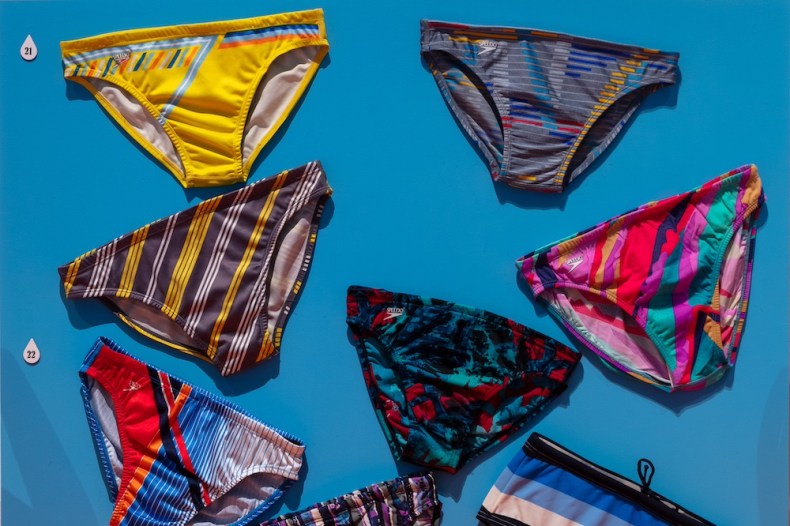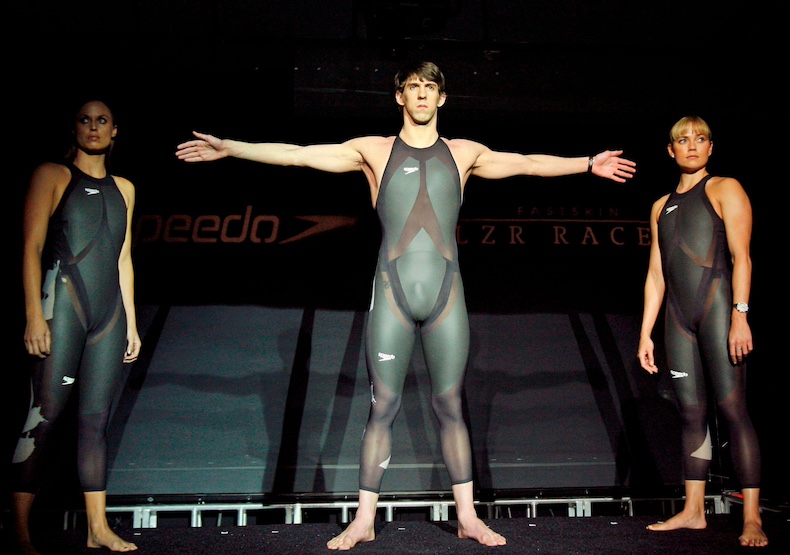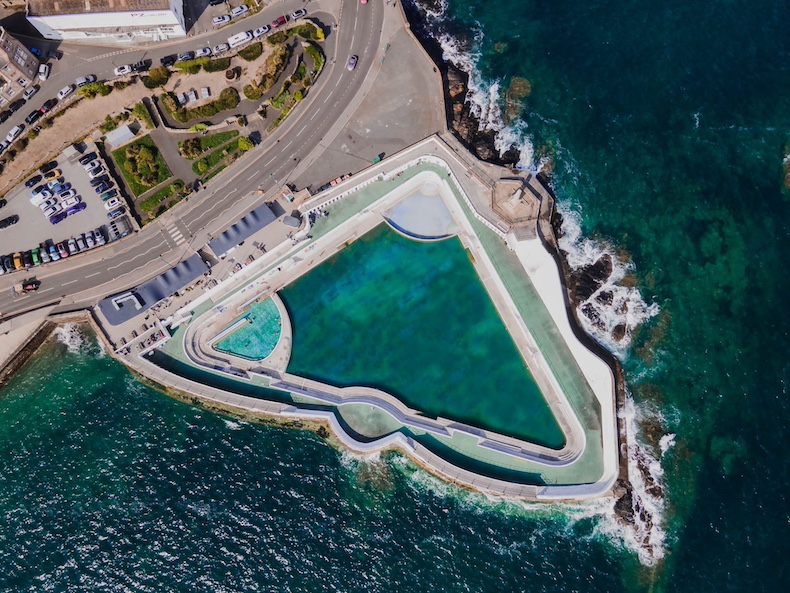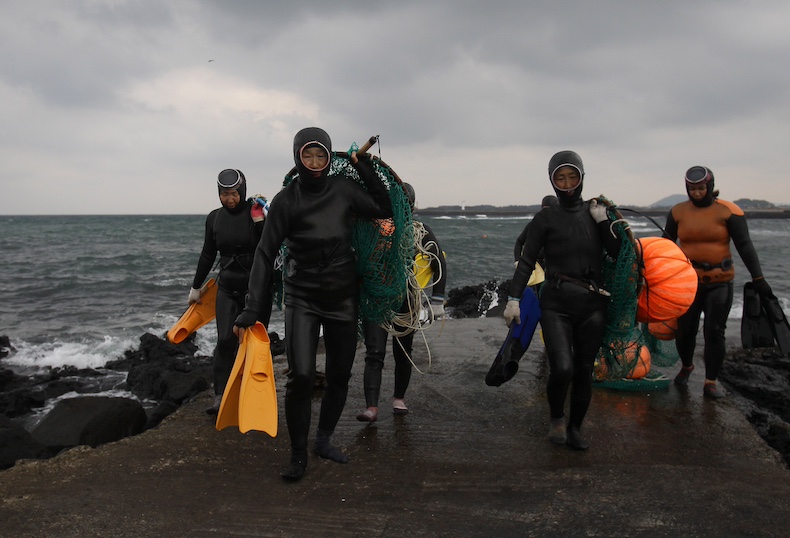If sexual intercourse, as Philip Larkin posited, began in 1963, then swimming, as the Design Museum would have it, began around 1923. That date is the starting point of its exhibition ‘Splash! A Century of Swimming and Style’, a dissection of swimming culture in the modern era, from the sportif to the sybaritic, spanning fashion, architecture and public taste.
Whether for survival, sport or recreation, humans have always found a reason to swim. Kind to bodies of all ages, shapes and dispositions, it is also the most sensuous form of physical exercise. The French poet and philosopher Paul Valéry described swimming as ‘fornication avec l’onde’. Somewhat perversely, then, one of the first objects on display is a baggy knitted sweater. This, it transpires, was created by Olympic diver Tom Daley, who is also renowned for the knitting skills that he often puts into practice poolside to pass time during competitions.
Along with his trunks, which he wore during his gold medal-winning performance at the 2020 Olympics in Tokyo, Daley’s jumper joins an eclectic assortment of swimsuits and beachwear spanning the decades. Laid out like colourful saints’ relics, they encapsulate the distance travelled from the era in which ‘bathing costumes’ were rented out at the beach – examples include a chaste, navy one-piece sternly stamped ‘Margate Corporation’ – to the LZR Racer, an ultra-high-performance swimsuit developed by Speedo with NASA and the Australian Institute of Sport. So high-performance, in fact, that it was eventually banned. Within this array, the fragment of the True Cross is Pamela Anderson’s sculptural red one-piece, based on the design of swimsuits worn by lifeguards in Southern California. Possibly ‘the most famous piece of swimwear in the world’, it stirred a billion loins every week as Anderson hurtled down the beach in slo-mo during Baywatch’s pomp in the ’90s.

A display of swimming trunks in ‘Splash! A Century of Swimming and Style’ at the Design Museum, London, in 2025. Photo: Luke Hayes; courtesy Design Museum
Advances in the technical development of water-resistant textiles came alongside the emergence of swimming goggles and caps, but swimwear’s real eureka moment came in July 1946, when French designer Louis Réard debuted a navel-exposing two-piece creation at the Molitor pool in Paris. Named after the site in the Marshall Islands where the United States conducted nuclear test explosions in the 1940s and ’50s, the bikini has never really looked back, though one of the earliest surviving examples, from 1951, featuring a newsprint design, might now be said to have lost some of its va va voom. A potted history of Speedos also gives due regard to the evolution of mens’ trunks. In the 1960s, Australian designer Peter Travis first reshaped the ‘Speedo brief’, as it was originally known, with a low-cut design ‘radically celebrating the male form’. And so the budgie smuggler was born, precipitating arrests at Bondi Beach when it was first paraded in public. A section on contemporary innovators looks at those who have helped challenge perceptions that swimmers should always be ‘beach body ready’. Examples include Hannah Whelan and Linda Souto Maior, whose Blob swimsuit, a white one-piece with an artfully rendered red crotch, was created to open up conversations around the stigma of swimming while menstruating.

American Olympic medalists Amanda Beard, Michael Phelps and Natalie Coughlin sporting Speedo LZR Racer swimsuits ahead of the Beijing Olympics in 2008. Photo: Kathy Willens/AP
In all this, architecture gets slightly short shrift, perhaps inevitably, as the guest curator, Amber Butchart, is a fashion historian best known from her stints on the Great British Sewing Bee. There are, however, dinky models of Zaha Hadid’s London Aquatics Centre – which resembles a futuristic giant slug – and the Jubilee Pool in Penzance, the largest seawater lido in the country (and one of only five left) as well as a tour de force of seaside art deco. Remodelled in 2021 by Scott Whitby Studio, who also designed this exhibition, it now harnesses geothermal energy to heat part of its triangular pool, allowing it to be used all year round.
Whether indoors, outdoors or in the wild, swimming pools are sites of pleasure and disinhibition, but they have always had a murkier side. In the United States, fears of ‘contamination’ by the presence of Black bathers led to a boom in private, backyard pools after the Second World War. Many public facilities closed permanently, rather than admit all patrons on equal terms. And in Australia, often regarded as a nation of swimmers, Indigenous citizens were regularly denied access to pools, sparking civil rights protests. Disparities persist today, with swimming proficiency skewed across different racial and ethnic groups.

The Jubilee Pool in Penzance, the largest seawater pool in the UK. Courtesy EyeOnHigh/Design Museum
In such a colourful and extravagant show, it would be easy to miss one of the most interesting exhibits: a plain white swimming cap belonging to champion swimmer Yusra Mardini, who competed for the first Refugee Olympic Team in Rio de Janeiro in 2016 and in Tokyo four years later. Mardini had fled the Syrian civil war just a year before the Rio Olympics: travelling on an overcrowded dinghy that began sinking in the Aegean Sea, Mardini and her sister Sarah swam alongside it for three hours, pulling it through the water and guiding everyone on board to safety on the island of Lesbos.
‘Splash!’ concludes with two short films, one on the haenyeo of Jeju Island in South Korea, a community of women freedivers who harvest sea urchins from the ocean floor, and the other on Swim Dem Crew, an inner city club focused on getting people of colour involved in swimming, whose founders have taught more than 200 Londoners to swim. Though worlds apart, both groups valorise social connection and the restorative power of being in water. This might be described as sublime, in its truest sense: as all swimmers know, elemental beauty often comes tinged with exquisite terror.

A group of haenyeo divers on Jeju Island, South Korea. Photo: Chung Sung-Jun via Getty Images
‘Splash! A Century of Swimming and Style’ is at the Design Museum, London, until 17 August














![Masterpiece [Re]discovery 2022. Photo: Ben Fisher Photography, courtesy of Masterpiece London](http://zephr.apollo-magazine.com/wp-content/uploads/2022/07/MPL2022_4263.jpg)
Suzanne Valadon’s shifting gaze